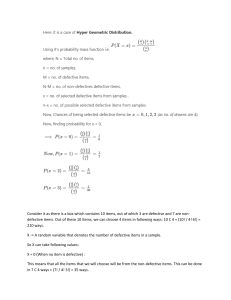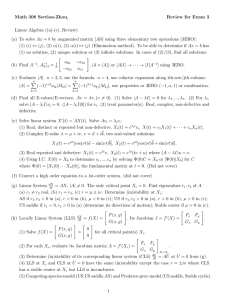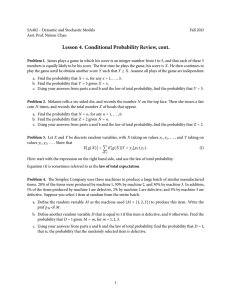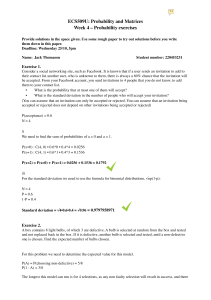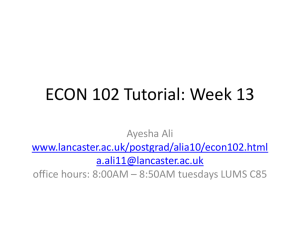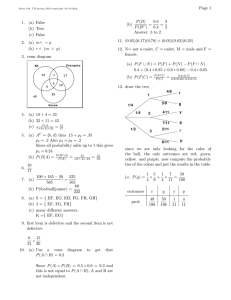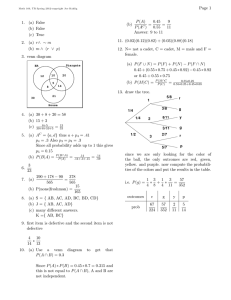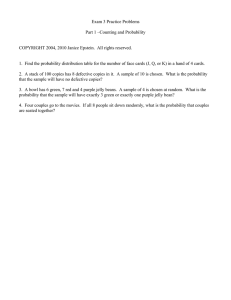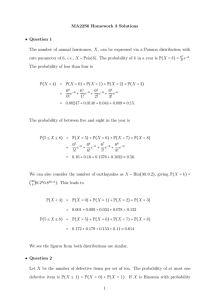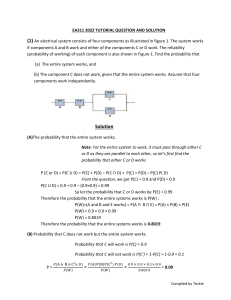Exam # 2 Review §Chapter 2. (From Section 2.5 only) 1. Q
advertisement
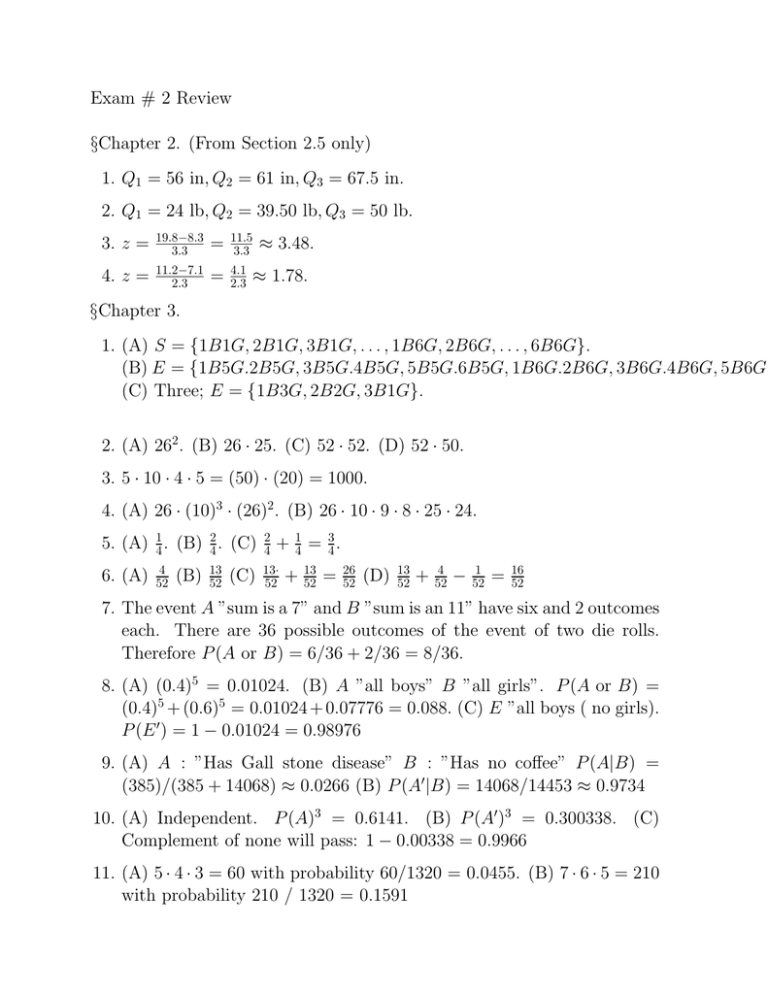
Exam # 2 Review
§Chapter 2. (From Section 2.5 only)
1. Q1 = 56 in, Q2 = 61 in, Q3 = 67.5 in.
2. Q1 = 24 lb, Q2 = 39.50 lb, Q3 = 50 lb.
3. z =
19.8−8.3
3.3
=
11.5
3.3
4. z =
11.2−7.1
2.3
=
4.1
2.3
≈ 3.48.
≈ 1.78.
§Chapter 3.
1. (A) S = {1B1G, 2B1G, 3B1G, . . . , 1B6G, 2B6G, . . . , 6B6G}.
(B) E = {1B5G.2B5G, 3B5G.4B5G, 5B5G.6B5G, 1B6G.2B6G, 3B6G.4B6G, 5B6G.
(C) Three; E = {1B3G, 2B2G, 3B1G}.
2. (A) 262 . (B) 26 · 25. (C) 52 · 52. (D) 52 · 50.
3. 5 · 10 · 4 · 5 = (50) · (20) = 1000.
4. (A) 26 · (10)3 · (26)2 . (B) 26 · 10 · 9 · 8 · 25 · 24.
5. (A) 41 . (B) 24 . (C)
6. (A)
4
52
(B)
13
52
(C)
2
4
+
13·
52
1
4
+
= 43 .
13
52
=
26
52
(D)
13
52
+
4
52
−
1
52
=
16
52
7. The event A ”sum is a 7” and B ”sum is an 11” have six and 2 outcomes
each. There are 36 possible outcomes of the event of two die rolls.
Therefore P (A or B) = 6/36 + 2/36 = 8/36.
8. (A) (0.4)5 = 0.01024. (B) A ”all boys” B ”all girls”. P (A or B) =
(0.4)5 + (0.6)5 = 0.01024 + 0.07776 = 0.088. (C) E ”all boys ( no girls).
P (E 0 ) = 1 − 0.01024 = 0.98976
9. (A) A : ”Has Gall stone disease” B : ”Has no coffee” P (A|B) =
(385)/(385 + 14068) ≈ 0.0266 (B) P (A0 |B) = 14068/14453 ≈ 0.9734
10. (A) Independent. P (A)3 = 0.6141. (B) P (A0 )3 = 0.300338. (C)
Complement of none will pass: 1 − 0.00338 = 0.9966
11. (A) 5 · 4 · 3 = 60 with probability 60/1320 = 0.0455. (B) 7 · 6 · 5 = 210
with probability 210 / 1320 = 0.1591
12. A : Psychology major. B : Male (A) P (A or B 0 ) = 11675/21575 +
525/21575 − 375/21575 = 0.5481 (B) P (A0 or B) = 21050/21575 +
9900/21575 − 9750/21575 = 0.9826 (C) P (A and B) = 150/21575 =
0.0070 (D) P (B|A) = 150/525 (E) P (A or B) = 9900/21575+525/21575−
150/21575 = 0.4762.
13. (A) 6! = 720 (B)
8!
(F) 2!·2!·4!
= 420
10 P2
= 90 (C) 8 C6 = 28 (D)
16!
13!·3!
= 560 (E)
10 C3
12 C4
=
8
33
14. 20 · 19 · 18 = 6840
15. 30 · 29 · 28 · 27 · 26 = 17, 100, 720
16. (A) To get no defective units, you must select 20 from 35 non-defective
units, and 0 from the 5 defective ones. This is then 35 C20 ·5 C0 =
3247, 943, 160
(B) 19 must work, and 1 must be broken. Then 35 C19 ·5 C1 (C) At
least 17 non-defective units are the events: A 17 non-defective, B 18
non-defective, C 19 non-defective, and D all 20 work. Add the number
of outcomes of events to get
35 C17 ·5
C3 +35 C18 ·5 C2 +35 C19 ·5 C1 +35 C20 ·5 C0
(D) At most two defective units is the union of events F none are
defective, G 1 is defective, and H 2 are defective. The number of
outcomes are
35 C15 ·5
C5 +35 C16 ·5 C4 +35 C18 ·5 C2
and the total number outcomes is that we pick 20 from all 40, or 40 P20
